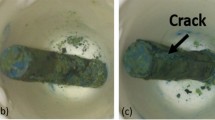Abstract
We analyzed the growth-rate diagrams for fatigue cracks in the modifications of a cermet alloy of the Ti–Si system in the initial state (the casted alloy) and after thermomechanical treatment. We used beam-like specimens tested under conditions of three-point bending in a corrosive medium (a 3% NaCl aqueous solution). It is established that, for various stress ratios, the parameter K max is more suitable for the description of changes in the growth rate of a fatigue macrocrack in the high-amplitude section of the diagrams than the parameter ΔK. Thermomechanically deformed metal ceramics are more sensitive to the effect of a corrosive medium than a casted alloy. The adverse influence of the medium increases with increase in the range of the stress intensity factor, which distinguishes the behavior of a preliminarily deformed cermet from that of traditional structurally homogeneous metal alloys.
Similar content being viewed by others
REFERENCES
B. D. Vasyliv, Structural Optimization of Ceramic Materials on the Basis of the Parameters of Crack Resistance [in Ukrainian], Author's Abstract of the Candidate-Degree Thesis (Technical Sciences), Lviv (1998).
O. N. Romaniv and G. N. Nikiforchin, Mechanics of Corrosion Fracture of Structural Alloys [in Russian], Metallurgiya, Moscow (1986).
O. N. Romaniv, S. Ya. Yarema, G. N. Nikiforchin, et al., Fatigue and Cyclic Crack Resistance of Structural Materials [in Russian], Naukova Dumka, Kiev (1990).
P. L. Andresen, “Corrosion fatigue testing,” in: Fatigue and Fracture, ASM Handbook, Vol. 19 (1996), pp. 193–209.
I. M. Dmytrakh and V. V. Panasyuk, Effect of Corrosive Media on Local Fracture of Metals near Stress Concentrators [in Ukrainian], Karpenko Physicomechanical Institute, Ukrainian Academy of Sciences, Lviv (1999).
O. P. Ostash, A. D. Ivasyshyn, B. D. Vasyliv, V. I. Mazur, and S. V. Kapustnikova, “Influence of the structure and asymmetry of loading cycles on the cyclic crack resistance of Ti-Si composites,” Fiz.-Khim. Mekh. Mater., 38, No. 1, 46–51 (2002).
V. I. Mazur, Y. N. Taran, and S. V. Kapustnikova, Titanium Matrix Composites, Patent 5366570, 22/11 USA (1994).
O. S. Kalakhan, Effect of the Structure, Corrosive Medium, and Continuous Renewal of the Surface on Durability of Titanium Alloys [in Russian], Author's Abstract of the Candidate-Degree Thesis (Technical Sciences), Lviv (1982).
O. Romaniv, V. Mazur, O. Tsyrul'nyk, et al., “Electrochemical behavior of titanium-based composites in a 3% NaCl solution,” in: Proceedings of the IV International Conference-Exhibition “Problems of Corrosion and Anticorrosion Protection of Materials,” [in Ukrainian], Lviv (1998), pp. 103–106.
Yu. S. Ruskol, Titanium Structural Alloys in Chemical Productions [in Russian], Khimiya, Moscow (1989).
I. L. Rozenfel'd, K. I. Afanas'ev, and V. A. Marichev, “Investigation of electrochemical properties of newly-formed surfaces of metals in solutions of electrolytes,” Fiz.-Khim. Mekh. Mater., 16, No. 6, 49–54 (1980).
Rights and permissions
About this article
Cite this article
Vasyliv, B.D., Ivasyshyn, A.D., Ostash, O.P. et al. Kinetics of Corrosion-Fatigue Cracks in Ti–Si Cermet Composite. Materials Science 38, 220–224 (2002). https://doi.org/10.1023/A:1020990103898
Issue Date:
DOI: https://doi.org/10.1023/A:1020990103898




